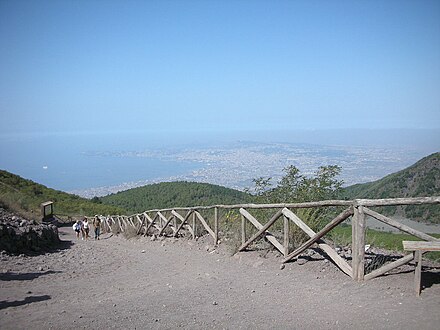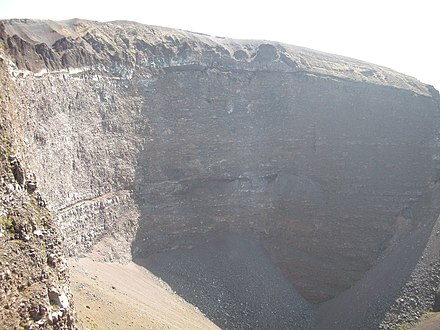Vesuvius - volcano on the southwestern coast of Italy
Mount Vesuvius (Italian: Monte Vesuvio) is a volcanic mountain in the Campania region of Italy, overshadowing the Bay of Naples.
Understand

Opening hours are Nov-Feb from 09:00 to 15:00, Mar Oct 09:00 to 16:00; Apr-Jun Sep: 09:00-17:00; Jul Aug: 09:00 to 18:00.
The entrance fee of €10 for an adult (€8 for a student) has to be paid at the entrance office and shown at the entrance gate (approx. 400 m further from the office). Update summer 2021: they don't sell entry tickets any more at the office, tickets can only be bought online. Wifi & instructions available at the office.
Going there will make you sweat a lot and set you back about €15 (including private taxi up the hill).
Get in
By public transport
From Naples
There's a direct bus-line that leaves twice a day from Naples Central Station square and goes straight up to the visitor parking. It's run by one of the minor bus companies (not the city transport) and you might have a bit of a hard time finding it, but unless you have a prearranged group tour it's perfect. It runs on a timetable, so it's less capricious than the taxi service from Ercolano. Two-way ticket from Naples Station runs at €13.50. Bus leaves at 09:20 and 10:35 at the Garibaldi station.
From Ercolano
Take the Circumvesuviana railway (Sorrento-Naples line). From Naples buy tickets on the lower level of the Central Station aka Stazione Centrale a Piazza Garibaldi, or bus to Ercolano Scavi station in Herculaneum or the Pompei Scavi station.
You can either wait for the local bus that costs around €8.70 return (from Pompeii, cheaper from Herculaneum/Ercolano). The bus goes only around twice a day from Herculaneum - at 08:45 and 12:45.
When you come out of the station, a private tourist office to your left runs trips up Vesuvius - €10 roundtrip, plus €8 admission fee. Downside is you only have an hour and 15 min to climb the summit and back - little time to rest. If you take longer than that, they leave you to fend for yourself or require you to pay another €5 per person for return. They also offer lifts to the ruins for €3.
From Pompeii
Among others, EAV bus directly from across the train station departs multiple times a day (every 50 minutes in season, perhaps with 2-3 hr break at 12:00) and takes approx. 40-50 minutes. The online timetable (dead link: January 2023) may not be accurate - more reliably it should be available (at least) at the tourist info point at Naples Garibaldi station and at the Pompeii train station.
Cost is €2.7 one way. The Campania Artecard is not accepted.
Conveniently, the bus stops in front of the ticket office, and departs back from the park entrance.
By taxi
You can use a private taxi company. From Ercolano Station you exit the station into a small square. Over to the left is a private tourist center. They offer a lift up and down the mountain for €10 each person. For €18, they will offer a ticket with entry to the crater. They are able to get special entry tickets for about €4.50, so when you purchase the package, they keep more than the €10. However, if you buy your own ticket to the crater, it's still €8 so you may as well pay them the €18. They will typically wait until a car (minibus) is full and leave then. They will agree with all people in the car to wait for all of you at the upper car park for 90 minutes. From the car park you'll have to hike up the last bit before you can actually see anything exciting. They say the walk is about 800 m long, going uphill most of the time and ending at the 1170-m mark. Wear good walking shoes as the trail is covered with dust and rock pebbles. If you have missed the public bus, this will be your only option to get up to the mountain.
The tourist information office is closed on Sundays.
You can also do a 6-km hike to the summit along the winding roads. To do this you will need to take the local bus service ANM 5 or 176 from Ercolano to San Vitto. From there you will be able to walk to the summit. You can take in the views of the national park and enjoy the local wildlife. You will still need to pay the entrance fee when you arrive at the crater, but for the energetic ones it is a must!
By car
You can get to the upper parking area, take the exit Ercolano from motorway and go up via the roads SP19 and SP140. Be prepared to part with at least €5 for the parking fee. Also it's a good idea to go there earlier in the morning to avoid the jams that may happen along the narrow road.
Get around
On foot
Everyone has to walk up the last 500 m steep-ish-ly uphill. That includes busloads of German pensioners, which on busy days will congest the path and give up half the way. Closed-in shoes are essential, as the path is full of dust and loose rocks. You might want to get hold of one or two walking sticks provided – but don't expect any hard-core hiking.
By mountain bike
Amore, the leader cycling company, arranges on-demand daily excursions along rough authorized paths of the volcano, opened for this company by the park. Different lengths and difficulties are available.
There are a couple of huts selling cheap and sometimes bizarrely inappropriate souvenirs and expensive drinks around the rim. Rather take a bottle of water with you.
Even on hot days, you can get strong and chilly winds at the rim, so take a lightweight fleece to wear at the top.
See

- The crater with its rising fumes.
- The different lava stones, changing colour as you walk uphill and around the crater.
- The view of the Bay of Naples and Pompeii in good weather.
- The scarred landscape where the 1950s lava streams went downhill.
- The remains of the funicular railway built in 1870, and which operated until the volcano's last major eruption in 1944. The song Funiculì, Funiculà was written by composer Peppino Turco, to commemorate the opening of the railway.
- All the other tourists.
Do
- Take a photograph that looks like you are going to parachute down the mountain.
- Enjoy the natural beauty of this worldly wonder.
- Hike one of the possible trails around the mountain.
Buy
- Geological collection sets with rare original Vesuvius stones. These are spray painted fakes.
- Postcards with a helicopter view of the volcano (since you won't get into one to snap the shots yourself).
- Property on the lower slopes of Vesuvius is very attractively priced.
- Lacryma Christi wine is produced from grapes grown on the lower slopes of the volcano.
Eat and drink
- While there are no pubs or restaurants, there are several small shops up the last 500 m or so to the crater and you can pick up snacks and a cool drink here but don't expect any meals, come well prepared!
Sleep
Stay safe
Vesuvius is an active volcano and may erupt any time in the near future. Over the last few centuries, Vesuvius has erupted at intervals ranging from 18 months to 7½ years, making the current lull the longest in 500 years. Its lack of eruption may merely indicate a build-up of pressure, which may result in a more explosive next eruption, posing a lethal hazard to over 500,000 residents living in the same place that was destroyed in 79 AD.
Listen to local authorities if there is any news about the state of Vesuvius, and do not wander any further than the trails go.
Go next
- Combine the trip to Vesuvius with visiting Herculaneum or Pompeii afterwards to make more of the day.
Related: Naples
Province of Naples
2nd-order administrative division
Campania
Primary administrative division